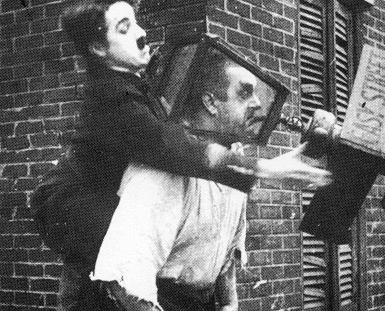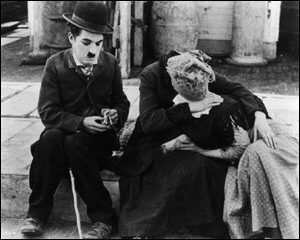 |
|
|---|---|
|
Dyskolos and It Happened One Night Structure |
Charlie ChaplinThe following is an analysis of the plot and struture of three Charlie Chaplin films: The Immigrant, The Count, and Easy Street Charlie Chaplin’s films have a different sort of plot from the smooth, unified storyline of most movies. They follow the movements of his tramp character in different situation. The central theme or situation is established in the opening scene, which begins the series of interconnected gags that make up the film. Among those gags there are patterns, certain scenarios that appear in each film. The tramp has a number of problems which he deals with in his own unique and highly comical way. He is always in need of money and must go about finding some way of acquiring it. He has at least on struggle with a villain character played by Eric Campbell, in which he always comes out on top and usually does so by sheer dumb luck. Finally, the tramp encounters a woman, usually played by Edna Purviance, and tries to woo her in some way.
The opening scene of each Chaplin film establishes the setting, the main character’s identity, and the comic atmosphere of the film. The first key to the subject of the film is the title. The Immigrant can easily be assumed to be about an immigrant traveling to the United States. The film opens with a shot of Charlie Chaplin’s rear-end, his legs flailing about while the upper part of him is hanging over the side of the boat, invisible from the camera’s perspective. This view immediately prompts laughter from the viewers and sets the tone for the rest of the film. The makers of the film do not take it seriously, and so neither should its audience. The title of The Count does not reveal as much about the film as that of The Immigrant, but is does give the impression that there will be money involved. In the opening scene, the tramp is taking a woman’s measurements, but he does not realize that when he measures her waist he puts the tape measure around the dress form behind her. He then cannot figure out how the woman’s waist can possibly be five feet around. He also measures parts of her body that are definitely not helpful in making clothing, such as her mouth and her fingernails. Thus the tramp is introduced as the incompetent tailor’s assistant and the gags begin. In Easy Street, the film begins with a shot of the tramp sitting on the ground outside of the Hope Mission. He goes into the Mission, cannot read the hymnal, and does not know how to feed the baby that the woman next to him passes to him. His failed attempts to read the music are hilarious, and his clumsiness with the baby bottle adds to the humble, uneducated image of the tramp that immediately establishes the comedic atmosphere of the film. Before too long, often right in the beginning, the tramp finds himself in trouble. This trouble is usually manifest in the form of the stock villain character played by Eric Campbell. In The Immigrant, the tramp encounters a number of problems at sea, including a card game with Eric Campbell’s villain character and two other men. The tramp does not seem to know the first thing about cards or betting, and he certainly does not know how to shuffle or deal, yet somehow he manages to come out on top. The tramp later encounters another villain, also played by Campbell, the waiter in the restaurant who beats up customers who cannot pay for their meals. Since the tramp has no money, the waiter presents quite a threat to his physical welfare. After some gags involving a fake coin and a battle of etiquette with an artist over who will pay the bill, the tramp ends up using the tip left by the artist to pay for hi own meal and once again escapes the wrath of the giant. In The Count, Campbell plays the tailor in whose shop the tramp works at the beginning of the film. Within a couple minutes of the opening, however, the tailor fires the tramp for burning through a pile of clothing with the iron. The tailor, having found an invitation to a party, decides to pose as Count Broko and try to win the hand of Miss Moneybags in marriage. The battle that ensues when the tramp happens to find himself at the party is quite chaotic and comical. The tailor presses him into service as his “secretary” and the two of them get into a struggle over Miss Moneybags, each stealing her from the other over and over again until they are revealed as imposters. The tramp ends up better off than the tailor only because he runs away while the tailor is caught and removed from the party. In Easy Street, Campbell’s villain is a bully on Easy Street who beats up all the policemen who are stationed there, leaving the police force in need of men. Chaplin’s tramp, in need of money, becomes a policeman and is assigned to Easy Street. Encountering the bully, he tries to avoid confrontation, almost calling the police. He ends up beating the bully twice, the first time using a gas lamp the bully bent over to anesthetize him, the second time dropping a stove out of a window on the bully’s head. The bully even reforms and comes to the New Mission at the end. The tramp is no match for the villain, but somehow he always conquers him in a roundabout and hilarious way. The plain image of Chaplin and Campbell opposing each other incites laughter because of Campbell’s sheer size next to Chaplin’s smaller, undernourished-looking frame.
In each film, the tramp is desperately in need of money. He is typically so poor that he does not have a nickel to buy a loaf of bread. In The Immigrant, he wins a large wad of money playing cards with the other men, but he gives most of it to the girl on the boat who has been robbed. Soon after arriving in the New World, the tramp is broke and hungry. Finding a coin on the floor, he puts it into his pocket and heads into a restaurant unaware that the coin has fallen straight through a hole in his pocket. The slapstick that follows involves Campbell’s villain and Edna Purviance’s pretty girl and ends in the afore-mentioned use of the artist’s tip for the waiter to pay the tramp’s bill. Upon leaving the restaurant, the artist hires both the tramp and the girl to work for him starting the next day, and gives them a couple dollars in advance. Thus the tramp’s financial difficulties are ended. In The Count, the tramp is out on the street after being fired by the tailor. He is so desperate that he goes to a kitchen where a woman is giving out nasty cheese and eats some of it. In order for the tramp to get to the party, the kitchen just happens to be in the house of Mrs. and Miss Moneybags, and the tailor and the tramp both try to woo Miss Moneybags to get at her wealth. The Count does not end in the tramp getting any sort of money. He simply runs away. This difference from the other Chaplin films is surprising and comical. In Easy Street, the tramp is penniless from the start. He almost steals the collection box from the Hope Mission, returning it after meeting the beautiful pianist. He then goes in search of a job, finding one at the police headquarters. This job turns out to be a very successful move for the tramp, as he defeats the bully of Easy Street and reforms the entire street. The New Mission is constructed at the end of Easy Street and even Campbell’s bully becomes a gentleman and goes to the Mission with a lady on his arm. The final element that is present in each of Chaplin’s films is the encounter with a beautiful woman, usually played by Edna Purviance. Typically, the tramp sees the woman, is immediately drawn to her beauty and performs some sort of gentlemanly act. Seeing her again later, he continues trying to win her affection. In The Immigrant, he first sees the woman when she walks into the dining room on the boat, and he gives her his seat at the table. He falls instantly in love with her. Afterward he sees her crying and tries to secretly put his money in her pocket when she tells him about her mother’s robbery. He is caught however, and she finds out. Later, in the restaurant, the tramp sees the woman there by herself crying and dressed all in black, and he finds out that her mother has died. He invites her to eat with him, pays for her meal, and once they are hired by the artist he asks her to marry him. She does not really accept his proposal, but he picks her up, throws her over his shoulder, and carries her into the marriage license office anyway. The Count does not have the same kind of encounter. The tramp somehow finds himself at Miss Moneybags’ party but he does not pursue her in the same way. He and the tailor vie for her because of her money and neither of them gets her. The tramp does see a beautiful woman in a stereotypical Arabian princess costume and having had a little to drink he tries to hit on her, but he succeeds only in starting a brawl and making a fool of himself. In the end he runs off alone. In Easy Street the tramp meets the beautiful young pianist at the Hope Mission in the beginning and stops himself from stealing the collection box. Later he rescues her from being raped by a heroin addict in a strange turn of events. He falls into the room where she is, lands sitting on a dope needle, and the resulting high gives him the strength and energy to save the girl, beat the entire mob of men upstairs and drop the stove onto the bully’s head. Thus he becomes the social savior of Easy Street by doing heroin. He also ends up with the girl on his arm as he walks to the New Mission at the end of the film.
Chaplin’s films are pure comedy. Though they deal with real life problems such as poverty, they poke fun at the little details of the problems. The structure is not a traditional or usual one with a beginning, middle, and end and in which the characters make choices and lead the plot in a certain direction. Rather Chaplin’s films are a series of gags that occur as a result of the tramp begin put into a certain situation. It’s as if Chaplin simply picks a setting, a bunch of props, and a role for each actor, and shouts “action.” The comedy comes from the tramp’s movements and reactions to his surroundings. It is fast-paced, energetic slapstick that carries the film. Each gag leads into the next and together they create some semblance of a plot that does not necessarily have a smooth or concrete storyline. They are dominoes that Chaplin lines up and knocks over, creating a picture of ironic humor in a dreary world.
Sources: Mast, Gerald. The Comic Mind: Comedy and the Movies. 2nd Ed. Chicago: The University of Chicago Press, 1979. The Immigrant. Dir. Charles Chaplin. Perf. Charles Chaplin, Eric Campbell and Edna Purviance. Mutual, 1917. The Count. Dir. Charles Chaplin. Perf. Charles Chaplin, Edna Purviance and Eric Campbell. Mutual, 1916. Easy Street. Dir. Charles Chaplin. Perf. Charles Chaplin, Edna Purviance and Eric Campbell. Mutual, 1917. |
For questions or comments, please contact John Gruber-Miller |
|


